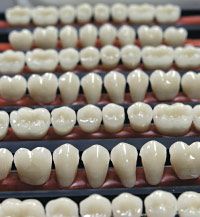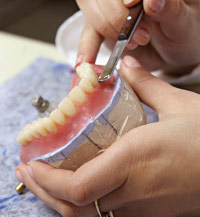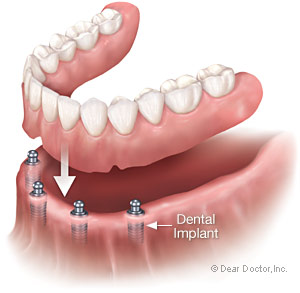Removable Full Dentures
A time-tested, affordable way to replace missing teeth
(Continued)
Ensuring Denture Success
What follows is a summary of the steps dentists take to construct removable full dentures that look and feel great.
 |
| Your dentist and laboratory technician choose from many different prosthetic tooth sizes and shapes to create your natural looking smile. Past photographs are important so your dentist can re-create your smile. |
A number of different estimates have to be made to determine where to place each tooth in a set of full dentures and how the upper and lower teeth should line up in relation to each other. Facial features are used as landmarks, and photos taken before the teeth were lost can help guide this process. Some important aesthetic and functional considerations are taken into account: What size should the teeth be and how much of them should show? How far forward or back from the lip should they be? How much space should be left between the upper and lower teeth when they are at rest? To some extent, a dentist has more flexibility with a completely edentulous (toothless) individual. For example, some individuals who have had a gap between their front teeth all their lives want it to look exactly the same. Others may want to have more natural, less uniform-looking teeth. Because there are a variety of options within what tooth positions will work, an experienced dentist can use clinical acumen and an artistic eye to achieve the desired results.
 |
| Setting up your teeth to create your smile and bite is as much an art as it is a science. |
The amount of gum tissue that shows when a person speaks or smiles depends on the natural position of the lip. It is particularly important to make artificial gums on dentures look realistic when the individual wearing them has what's called a “high lip dynamic” (when the lip rises above the teeth, exposing the gum). Many colors and textures can be added to simulate the appearance of real tissue. Again, good photos of the individual before tooth loss can be useful in helping to achieve this effect. In addition, the little ridges of tissue in the palate behind the upper front teeth (called palatal rugae) can be added to the denture for clarity of speech, particularly the “th” sound; ease of chewing lumpy food; and reduced spitting when talking.
Balancing the biteProbably the most important aspect of full-denture design and fabrication for a clinician to master is balancing the bite. The upper and lower dentures must come together in order to stabilize each other, so that biting, chewing and speech are normal.
Maintaining the outcomeUltimately everything changes, including prosthetic (false) teeth and the real tissues and bone on which they rest. A person with dentures must visit the dentist regularly to ensure continual good fit and function of the dentures, and health of the denture-bearing tissues. Bone loss is the enemy and its rate is unpredictable, varying from person to person. So professional monitoring is essential.
 |
| The greater the number of implant attachments, the more stability a denture will have during function. |
Finale
Once the teeth have been placed in the position initially dictated by the wax rims, they are placed into the mouth for fit, function and looks. The dentures are then “processed” in a dental laboratory. The wax is exchanged for resilient oral tissue colored (pink) denture plastic, methyl methacrylate. The teeth, of the same material, can be artistically characterized to make them look natural.
A small percentage of people cannot tolerate removable dentures at all, sometimes because they dislike having their palate covered. For these individuals, hybrid forms of implant-supported dentures offer a good alternative to full dentures. Strategically placed dental implants rigidly support the dentures so that the palatal tissue does not have to be covered, while still replacing the teeth and providing necessary support for the face and lips.
The foundation of success with removable full denture prosthetics (false teeth) is a partnership between a talented clinician and a willing patient. While there are clinical rules and oral landmarks to use as guides, it takes a certain feel, art, and experience for a dentist to figure out how to make a set of upper and lower teeth that fit, function and look normal — especially when all the natural teeth have been missing for a long period of time. And it can be difficult for an individual to get used to wearing false teeth where natural teeth used to be. But hope springs eternal, dentistry is resourceful, and human beings are highly adaptable.





